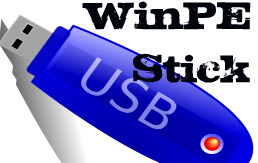How To Make and Use a Bootable WinPE Drive

USB Flash Drives
Vista has crashed and your PC will no longer even boot up into the operating system—what to do? It turns out that your USB thumb drive can save the day. You can use what Microsoft calls UFD (for a USB flash drive) with a Windows image file (.wim) for Windows Preinstallation Environment that offers a quick-start way to access the System Recovery Options. But besides saving your skin when your PC will not boot up, this bootable drive can also do lots of other interesting things. In the pages that follow, we describe exactly how to build such a device and explore some of the useful tasks that it can accomplish.
Every copy of Windows Vista comes with installation disks or files that include a special pared-down version of the operating system, which Microsoft calls Windows Preinstallation Environment 2.0, but it is more often known as Windows PE or even WinPE.

You may not think you’ve used WinPE before, but you probably have. When you install Windows Vista, for example, the code that enables you to load a command-line environment, as well as the Windows Recovery Environment (also known as Windows RE or WinRE), comes straight from WinPE. While Microsoft won't admit it publicly, it is the Windows Preinstallation Environment, aka WinPE, that allows one to create a bootable UFD–instead of using the more time-consuming Windows Recovery Environment, also known as WinRE.
Get instant access to breaking news, the hottest reviews, great deals and helpful tips.
Current page: How to Make a Bootable Windows PE USB Drive - Tom’s Guide
Next Page Create a Bootable WinPE USB Drive - What You Need - Tom’s GuideEd Tittel is a freelance writer, trainer, and internet consultant. His work has appeared on many sites, including Tom's Guide, Tom's Hardware, TechTarget, and more. He has also contributed to multiple books, including the "For Dummies" series, where he wrote about HTML, HTML4, XHTML, XML, and CCS. He was also series editor of the Exam Cram books until 2005.
-
masterwhitman What, no mention of BartPE or UBCD4Win (Ultimate Boot CD for Windows)? These are two projects that are vastly superior to Microsoft's method (both are built on WinPE but have expanded capabilities) and are far easier to use.Reply -
when I saw this I thought it was going to be a review of Bart's PEBuilder... It's saved my a$$ many times. Far superior to WinPE...Reply
How about a comparison/companion article? or an article on tools gearheads & techies find indespensible? -
average joe Vista's PE is far more advanced than XP's. The BartPE project is based of XP's PE. Barts is amazingly useful and I can't wait till they move to from PE 1.1 to PE 2.0.Reply
Some "fairly new" systems will not boot from usb so always carry a cd version as a backup. -
"I usually grab Imagex.exe and the Package Manager using the commands shown in the next screen capture."Reply
Hmmm... I don't see a 'next screen capture' showing the commands used to get imagex and Package Manager. -
LightWeightX Good start to the guide until you get to the WinRE. In section 5, step 2, you describe using imagex and the secret is the number 2 argument however you do not give an example of the command. In the WinPE you use a 240 MB partition, then in WinRE you state you need at least 512 MB.Reply -
sdybas Show us howto "use imagex to grab the Windows RE image from the Vista-installation media." Thanks.Reply -
Good article, but it makes a few omissions and goofs here and there.Reply
1. For using imagex to grab the WinRE image, check out this link:
http://blogs.msdn.com/winre/archive/2006/12/12/creating-winre-using-waik.aspx
2. "x64" won't work when you're using copype.cmd - it has to be "AMD64". Just replace all instances of x64 with AMD64 in this procedure, and it'll work.
3. For the image showing how to grab imagex and the package manager, click on the picture above the text to open up the gallery, then click one pic forward.
